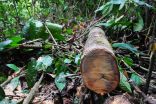Water could have been abundant in the first billion years
2015-04-28
(Press-News.org) How soon after the Big Bang could water have existed? Not right away, because water molecules contain oxygen and oxygen had to be formed in the first stars. Then that oxygen had to disperse and unite with hydrogen in significant amounts. New theoretical work finds that despite these complications, water vapor could have been just as abundant in pockets of space a billion years after the Big Bang as it is today.
"We looked at the chemistry within young molecular clouds containing a thousand times less oxygen than our Sun. To our surprise, we found we can get as much water vapor as we see in our own galaxy," says astrophysicist Avi Loeb of the Harvard-Smithsonian Center for Astrophysics (CfA).
The early universe lacked elements heavier than hydrogen and helium. The first generation of stars are believed to have been massive and short-lived. Those stars generated elements like oxygen, which then spread outward via stellar winds and supernova explosions. This resulted in "islands" of gas enriched in heavy elements. Even these islands, however, were much poorer in oxygen than gas within the Milky Way today.
The team examined the chemical reactions that could lead to the formation of water within the oxygen-poor environment of early molecular clouds. They found that at temperatures around 80 degrees Fahrenheit (300 Kelvin), abundant water could form in the gas phase despite the relative lack of raw materials.
"These temperatures are likely because the universe then was warmer than today and the gas was unable to cool effectively," explains lead author and PhD student Shmuel Bialy of Tel Aviv University.
"The glow of the cosmic microwave background was hotter, and gas densities were higher," adds Amiel Sternberg, a co-author from Tel Aviv University.
Although ultraviolet light from stars would break apart water molecules, after hundreds of millions of years an equilibrium could be reached between water formation and destruction. The team found that equilibrium to be similar to levels of water vapor seen in the local universe.
"You can build up significant quantities of water in the gas phase even without much enrichment in heavy elements," adds Bialy.
This current work calculates how much water could exist in the gas phase within molecular clouds that will form later generations of stars and planets. It doesn't address how much water would exist in ice form (which dominates within our galaxy) or what fraction of all the water might actually be incorporated into newly forming planetary systems.
INFORMATION:
This joint project was carried out as part of the Raymond and Beverly Sackler Tel Aviv University - Harvard Astronomy Program.
[Attachments] See images for this press release:

ELSE PRESS RELEASES FROM THIS DATE:
2015-04-28
LOS ANGELES (April 28, 2015) - An international team of scientists led by a Cedars-Sinai researcher has identified a new genetic mutation that appears to protect people from developing Type 2 diabetes.
The finding could lead to the development of new drug therapies to treat about 26 million Type 2 diabetics in the United States who rely on insulin and oral medication to manage the life-threatening disease for which there is no cure.
"We have a wonderful opportunity to personalize the treatment and prevention of this chronic disease," said Mark O. Goodarzi, MD, PhD, ...
2015-04-28
Global carbon emissions from forests could have been underestimated because calculations have not fully accounted for the dead wood from logging.
Living trees take in carbon dioxide whereas dead and decaying ones release it. Understanding the proportion of both is important for determining whether a large area of forest is a source of carbon dioxide, or a 'sink' that helps to absorb carbon dioxide from the atmosphere.
Forestry, agriculture and land-use changes account for nearly 25 per cent of global greenhouse gas emissions, second only to the energy sector. New research ...
2015-04-28
WASHINGTON, April 28, 2015 -- Science fans, assemble! On May 1, the world's top superhero team is back to save the day in "Avengers: Age of Ultron." This week, Reactions looks at the chemistry behind these iconic heroes' gear and superpowers, including Tony Stark's suit, Captain America's shield and more. Check out the video here: https://youtu.be/Gr3ov7R89Xo.
Subscribe to the series at http://bit.ly/ACSReactions, and follow us on Twitter @ACSreactions to be the first to see our latest videos.
INFORMATION:
The American Chemical Society is a nonprofit organization ...
2015-04-28
A new study found that sexual function in adult living donors was lower at the evaluation phase and at three months following liver transplantation. Results published in Liver Transplantation, a journal of the American Association for the Study of Liver Diseases and the International Liver Transplantation Society, suggest that donor education prior to surgery may improve recovery and ease concerns about sexual function following the transplant.
Living liver donors provide a healthy portion of their liver to an individual with end-stage liver disease. These donors make ...
2015-04-28
COLUMBUS, Ohio - Researchers have identified two seemingly unrelated but strong predictors of obesity: having low self-esteem related to one's weight and keeping food visibly available around the house, outside the kitchen.
The Ohio State University study focused primarily on determining whether the home environment - architectural features and food storage and availability - was associated with obesity, but also measured a number of psychological factors. While architectural features had no relationship to obesity status, several food-related findings did.
People in ...
2015-04-28
In reconstructive and esthetic medicine, a technique called cell-assisted lipotransfer, i.e., the grafting of the patient's own adipose tissue to another site in the body after mixing with autologous stem cells, is being increasingly used and aggressively promoted. This technique has not been shown to yield better outcomes than conventional lipotransfer without cell enrichment, as discussed by Soraya Grabin and coauthors in a current article in Deutsches Ärzteblatt International (Dtsch Arztebl Int 2015; 112: 255-61). The vitally important matter of safety--in particular, ...
2015-04-28
San Francisco, CA, April 28, 2015 - Many eye disorders in young children are asymptomatic and may remain undetected without testing. Since effective treatments are available for many of those conditions, early identification and intervention are critical to prevent potentially permanent vision problems. A new report published in the Journal of the American Association for Pediatric Ophthalmology and Strabismus (AAPOS) describes the effectiveness of a new computer-based vision-screening test, the Jaeb Visual Acuity Screener (JVAS), which is suitable for use in schools and ...
2015-04-28
Amsterdam, April 28, 2015 - The demise of Neanderthals may have nothing to do with innovative hunting weapons carried by humans from west Asia, according to a new study published in the Journal of Human Evolution. The researchers, from Nagoya University and The University of Tokyo, Japan, say their findings mean that we may need to rethink the reasons humans survived Neanderthals - and that we may not have behaved as differently as we thought.
The researchers looked at innovative stone weapons used by humans about 42,000-34,000 years ago. Traditionally, anthropologists ...
2015-04-28
EVERGLADES NATIONAL PARK, Fla.-- The largest and longest Burmese Python tracking study of its kind -- here or in its native range -- is providing researchers and resource managers new information that may help target control efforts of this invasive snake, according to a new study led by the U.S. Geological Survey.
Among the findings, scientists have identified the size of a Burmese python's home range and discovered they share some "common areas" that multiple snakes use.
"These high-use areas may be optimal locations for control efforts and further studies on the ...
2015-04-28
People starting to plan for retirement or other big goals should pull out a calculator and multiply the years ahead by 365. Measuring time in days instead of months, or months instead of years, can make future events seem closer and thus more urgent, according to new research published in Psychological Science, a journal of the Association for Psychological Science.
When units of time were manipulated to bring important events closer to the forefront psychologically, people reported that they should start to plan and save significantly earlier, even when future events ...
LAST 30 PRESS RELEASES:
[Press-News.org] Water could have been abundant in the first billion years


